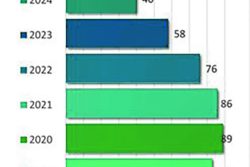The fact that the Caribbean and Latin America are badly lagging behind member countries of the Organization for Economic Cooperation and Development (OECD) is stymying development in the hemisphere and points to the need for urgent and significant investment in broadband penetration in order to close the digital divide, a recent study by the Inter-American Development Bank (IDB) says. But any really meaningful closure of that gap will impose a heavy financial burden on a hemisphere whose economies have already had to cope with the ravages of the more than year-long coronavirus pandemic, the IDB study declares.
“Delays in improving connectivity and digitalization in Latin American and Caribbean countries have dramatically exacerbated the economic and social impact of COVID-19. But this reality also offers a historic opportunity to reduce inequality, and create jobs and sustainable economic growth,” IDB President Mauricio Claver-Carone says.
 The study says that Latin America and the Caribbean are likely to dramatically increase employment and generate sustainable economic growth if those countries can meaningfully close their digital connectivity gap with OECD countries.
The study says that Latin America and the Caribbean are likely to dramatically increase employment and generate sustainable economic growth if those countries can meaningfully close their digital connectivity gap with OECD countries.
Closing the gap with OECD countries would create over 15 million direct jobs, boost regional economic growth (GDP) by 7.7 per cent, and increase productivity by 6.3 per cent, according to the study. Titled “Digital Gap in Latin America and the Caribbean: Annual Broadband Development Index Report”, the study seeks to evaluate the state of broadband penetration in twenty six (26) countries in the region and estimates the size of the gap vis-à-vis Organization for Economic Cooperation and Development (OECD) nations.
The IDB says that delays in improving connectivity and digitalisation in Latin American and Caribbean countries have dramatically exacerbated the economic and social impact of COVID-19, though it adds that the circumstances also offer a historic opportunity to reduce inequality, and create jobs and sustainable economic growth. Claver-Carone says that “the IDB is taking steps to drive a digital ecosystem that will help the region attain these investments, design national broadband plans, and create the public-private partnerships needed to expand coverage for all citizens, especially those who are most vulnerable.”
Any meaningful closure of the digital gap, the IDB says, will set the hemisphere back US$68.5 billion, an amount that it would hardly be in a position to afford at this time. The Bank is recommending that of the amount, around 59% should be allocated to improving connectivity in urban areas and 41% should be allocated to rural areas. Closing the gap, the study says, would also require the application of public/private partnerships. The Report reflects the fact that the region still has major broadband penetration and 4G technology coverage gaps compared with OECD countries. Affordability is also likely to be a challenge in Latin America and the Caribbean.
Limitations in the reach and efficiency of communication here in Guyana have been most felt in just over the past year with the advent of Covid-19 and the necessity to shift to virtual communication in key areas including education delivery.








